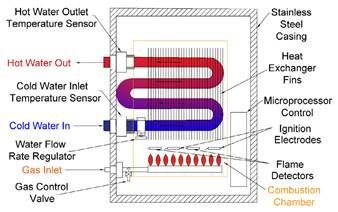
Hot water generation can contribute to as much as 40% of the energy costs of a typical residential building and therefore has a substantial operating cost. Considering all available hot water generation options enables the client to reap the full benefits of an optimised solution for the specific application.
There are a number of solutions available to assist architects and fellow engineers to satisfy the hot water generation regulations as well as client requirements.
Gas water heaters use either natural gas or liquified petroleum gas to heat water with the most common type being the instantaneous gas water heater. Simply put, the gas is burned inside the water heater to provide heat to the domestic water when it passes through the flame. The outlet water temperature is setpoint controlled and there are strict guidelines associated with the installation of these heaters. The main benefit of gas water heaters is that they are able to operate without electricity which provides redundancy during electricity outages. The main disadvantage of gas water heaters is that a certified gas installer is required for the installation and maintenance and cannot be completed by a plumber that is not correctly qualified.

Air to water heat pumps use the heat of the outside ambient air to produce domestic hot water. Heat is absorbed from the air to a refrigerant fluid which is passed through a compressor, increasing the temperature and resulting in the heat being transferred to the water passing through the heat exchanger. In this manner, there is a positive coefficient of performance with more thermal heat produced than the electricity required to drive the compressor. The main benefit of a central heat pump system is the efficiency achievable over electric resistance heating and other systems, as well as the low maintenance costs involved. This system often has the lowest lifecycle costs of all options for commercial clients. The main disadvantage of this system is that the hot water storage tanks will be kept on temperature by the heat pumps, using electricity, without any flow demand by tenants. This makes the utility metering more complex but is easily solved when the system is designed correctly.

Hybrid gas water heater and heat pump systems utilise the best of both systems with the instantaneous water heating capabilities of the gas water heaters to satisfy the varying peak hot water demands and the efficiency of the heat pump system providing the bulk water or base load heating to the storage tanks. The main advantage of this system is that it is able to operate during electricity outages and provides a higher efficiency for the bulk water heating when compared to electrical resistance heating elements. The main disadvantage of this system is that the maintenance of the gas water heaters may only be done by a certified gas installer.

Solar thermal hot water heaters effectively absorb heat from the sun to produce hot water. Since solar irradiance is experienced for a limited time per day from 10am to 4pm with the peak between 12pm to 2pm, these systems are not always able to meet the peak hot water demand for most commercial buildings and are mostly used for preheating purposes in conjunction with electrical resistance heating elements. There are several solar thermal water heaters available on the market with direct and indirect configurations utilising either evacuated tube collectors or flat panel collectors. Each should be evaluated respectively for the geographic region, roof support system and client requirements. The main advantage of solar thermal water heating systems is that the solar irradiance heat produced by the sun is free energy. The main disadvantage from solar water heating systems is that you are reliant on weather conditions and an overcast day, for example, reduces the free energy received by each collector.

In the commercial space the choice of water heating system is being driven by very specific drivers.
The commercial sector in South African will need to balance compliance, lifecycle costs and finite resource management to achieve the best solution. Businesses that attach value to their hot water generation systems and water systems in general will ensure a low-cost, reliable and sustainable solution that assists in the growth and longevity of their businesses.